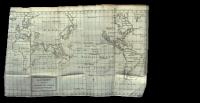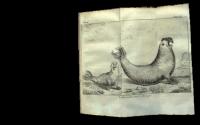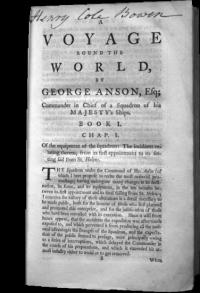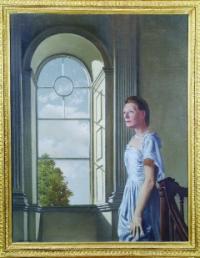An ‘island’ of cosmopolitan culture: Anson’s Voyage round the world and the library at Bowen’s Court, Co. Cork
Published in 18th–19th - Century History, Features, Issue 5 (Sept/Oct 2011), Volume 19
Frontispiece chart showing the track of HMS Centurion from Richard Walter’s A voyage round the world by George Anson (Dublin, 1748). (Private collection)
Commodore George Anson’s voyage is remembered as a classic tale of endurance and leadership in the face of fearful disasters, but to the British public of 1744 it was the treasure of the Spanish galleon triumphantly paraded through the streets of London that did something to restore national self-esteem battered by the protracted War of Austrian Succession (1740–8). First published in 1748, Richard Walter’s account of Anson’s circumnavigation (1740–4) was phenomenally popular throughout the eighteenth century. It went through many editions in English, was translated into numerous foreign languages (including French, Italian, German and Russian), and has been republished so many times that probably nobody knows how many editions of it have appeared in print. A Dublin edition of Walter’s narrative, discussed here, was originally part of the holdings of a private gentleman’s library at the eighteenth-century estate at Bowen’s Court, Co. Cork. How can this artefact offer a window into Ascendancy culture?
Constructing Richard Walter’s narrative
In the summer of 1744, the return of HMS Centurion provided ample copy for London’s press seeking to restore national pride in the wake of the Mediterranean fleet’s failure off Toulon in February. In newspapers, Anson was compared with Sir Francis Drake, who had circumnavigated the globe in 1577–80. Anson was promoted accordingly. In 1751 he was appointed first lord of the admiralty and continued to hold the office, with the exception of an interval of a few months, until his death on 6 June 1762, being thus the head of the naval service through the greater part of the Seven Years’ War (1756–63). Some of the fame of Anson’s expedition had resulted from the published accounts of survivors of Anson’s ship Wager, wrecked off the Patagonian coast and vividly described by John Byron, known as ‘Foulweather Jack’, grandfather of the poet Lord Byron. Although several private journals of the voyage had been published, the official version of events was eagerly awaited. Richard Walter’s account was published in the wake of a protracted legal dispute, between August 1744 and May 1747, concerning the division of the prize money amongst the officers of the expedition.

Engraving of a sea lion and lioness based on a sketch by Piercy Brett, a lieutenant on board the Centurion, one of 42 detailed charts and engravings that laid the basis for later scientific and survey expeditions by Captain James Cook. (Walter’s Voyage)
Richard Walter’s account of George Anson’s circumnavigation is a transition narrative, emerging out of the hard-bitten privateer accounts of seventeenth-century buccaneers like William Dampier and Woodes Rogers, yet pointing towards a more scientific approach that was to characterise future accounts of maritime expeditions. Walter, the expedition’s chaplain, had accompanied Anson aboard the Centurion until China, and reconstructed the remainder of his account from other eyewitnesses. Regarding questions of authorship, Glyndwr Williams, emeritus professor, Queen Mary, University of London, concludes that, in substance, the narrative was Anson’s account, ghosted for him by an accomplished writer, and it should be regarded as an apologia for Anson’s own conduct rather than as an impartial memoir. Walter may have commenced the work and saw it through to press, but Benjamin Robins, a versatile mathematician and experienced pamphleteer, was primarily responsible for its literary quality. Both contributions can probably never be completely disentangled, however. Historian Niall Ferguson has credited Robins, author of the New principles of gunnery (1742), as being at the vanguard of the ballistics revolution, whereby scientific principles became applied to military processes on an industrial scale, thereby enabling Britain’s wholesale pursuit of empire. Walter’s compilation is the most comprehensive account of this landmark circumnavigation. Not only does it recount daily life at sea but it also includes vivid descriptions of the islands and lands visited. The account is excellent at providing political and historical information that allows the reader to understand the narrative in context. The pen-sketch of Anson is of a concerned captain and it is easy to see why his career was so spectacular. As well as detailing the adventures of the expedition, the book contained useful information for future navigators and, with 42 detailed charts and engravings in the quarto editions, most based on pencil drawings by Piercy Brett, a lieutenant on board the Centurion, it laid the basis for later scientific and survey expeditions by Captain James Cook. The scattering of Anson’s expedition in the South Atlantic was partly due to a failure to fix longitude. Paradoxically, it was the expedition’s flagship, the Centurion, that had taken part in early sea trials of John Harrison’s H-1 chronometer in 1736. The longitude question was only resolved, in the wake of the voyages of Captain Cook, at the end of the eighteenth century. Still, Richard Walter’s account was to retain relevance. A first edition of Walter’s narrative formed part of a portable library on board HMS Beagle during Charles Darwin’s survey of Tierra del Fuego in 1831. The first edition of Walter’s narrative was published by John and Paul Knapton at the Crown in Ludgate Street, near the west end of St Paul’s Cathedral, London, in 1748, in both quarto and abridged octavo editions with copper-engraved plates, plans, charts and maps, folding or double-page.

The signature of Henry Cole Bowen on his copy of Walter’s Voyage, most likely the ‘Henry III’ and ‘Henry the Builder’ described by Elizabeth Bowen in her family memoir, Bowen’s Court. (Crawford Art Gallery, Cork)
An Irish edition of Walter’s narrative
Historian Glyndwr Williams attributes the success of Walter’s narrative to the fact that it went through five editions during its first year of publication in 1748. This assertion, however, is based on English editions. An Irish edition of Walter’s narrative, printed by George and Alexander Ewing at the Angel and Bible, Dame Street, Dublin, also appeared in 1748. This smaller octavo edition reproduces eight of the most ‘useful and ornamental’ plates from the larger quarto edition. An advertisement, prefacing this edition, informs the reader that the remaining plates may be purchased separately from Ewing booksellers in Dame Street. Dublin was the second city in the three kingdoms, with its own university and parliament. Máire Kennedy and Mary Pollard argue that London and Dublin depended on each other in the flourishing publishing industry during the eighteenth century. Ireland’s book trade, centred in Dublin, Belfast and Cork, compared favorably with flourishing book markets in London, Paris, Amsterdam, New York, Boston, Philadelphia and Baltimore. After 1680, Ireland’s premier book hub in Dublin was a stalwart ‘inky brotherhood’ of printers, booksellers, bookbinders, press operators, engravers, hawkers and others. Audiences ranged from gentleman scholars to the general public. Dublin printers and booksellers, like thefamily firm of George and Alexander Ewing, did negotiate reprint rights from London publishers despite the operation of a pirate book trade. Anson’s Voyage had a very broad appeal. Dorothea Herbert in her autobiography, describing her life in eighteenth-century upper-class Irish society, recalls playing childhood games inspired by voyages to the South Seas as related in Robinson Crusoe and tales of Juan Fernández from her reading of a ‘sixpenny voyage of Lord Anson’.Book I in the Ewing edition of Walter’s narrative is inscribed with the signature of Henry Cole Bowen in a cursive copperplate hand.

Elizabeth Bowen portrait by Patrick Hennessy
He is most likely to be the Henry known by Elizabeth Bowen as ‘Henry III’ and ‘Henry the Builder’ in her family memoir, Bowen’s Court, who built his country seat of Bowen’s Court at Farahy, near Kildorrery, Co. Cork, in 1775. Henry Cole Bowen, known to the locals as ‘Cooleen’, was a considerable presence in the Mallow society of the day. He fathered fourteen children and was to leave a legacy of substantial debt owing to his extensive building projects.
Libraries formed the intellectual and discursive heart of the eighteenth-century country house. In Elizabeth Bowen’s memoir Bowen’s Court,published in 1942, she describes the process of cultural and intellectual transmission in Ireland during the Age of Enlightenment:
‘. . . rational thought from Paris—with delays, lacunae and misunderstanding like a long-distance telephone call—travelled via London and Dublin to County Cork, and the Age of Reason did just this for Mallow: one assumed that God was not after one the whole time’.
An assessment of the library at Bowen’s Court, reconstructed from readings of Bowen’s memoir, indicates that it contained editions that fitted into the Anglo-Irish ideal of humanist culture, military prowess and political versatility. George and Alexander Ewing’s edition of Anson’s voyage formed part of the book stock at Bowen’s Court until the house was sold in 1959 and demolished in 1960. At the request of Mrs E.D.C. Cameron (Elizabeth Bowen’s married name), the library’s collection was sold at public auction by Marsh & Sons Ltd at their salesroom, 70 South Mall, Cork, on Wednesday 5 April 1961.

An engraving of the island of Juan Fernández based on a Brett sketch. (Walter’s Voyage)
Conclusion
The popular dissemination of Anson’s circumnavigation through newspapers, magazines, popular fiction, diplomatic memoranda and scientific treatises is indicative of the processes by which the colonial expansion of Britain during the eighteenth century necessitated the construction of narratives to validate the imperial project, in the first instance in the South Seas (South Atlantic and Pacific Oceans). Walter’s narrative helped to convince the British government of the strategic significance of the South Atlantic and its islands. Captain John McBride, originally from Ballymoney, Co. Antrim, was the first to survey the Falkland Islands (Islas Malvinas) for Britain in 1766.The theme of islands, as a metaphor for the Ascendancy class, threads through Elizabeth Bowen’s memoir. The library at Bowen’s Court was an ‘island’ of cosmopolitan culture. Reflecting on the composition of her memoir, Elizabeth Bowen wrote:
‘Bowen’s Court in that December of 1941 in which this book was finished, still stood in its particular island of quietness, in the south of an island country not at war. Only the wireless in the library conducted the world’s urgency to the place.’
It is sobering to imagine that Ewing’s edition of Anson’s Voyage, a book so concerned with the politics of islands, could have been on the shelves in that darkened library at the time of her writing. HI
Acknowledgements
The author wishes to thank Michael Waldron for his assistance in identifying the Bowen provenance of the Dublin edition, and Cronan Ó Doibhlin, Boole Library, UCC. This paper is dedicated to the memory of Donal R. Cronin (1922–97), who acquired the Dublin edition of Anson’s voyage on the Falkland Islands and returned it to Cork.
James Cronin is a staff member in the School of History and the Centre for Adult Continuing Education at University College Cork.
Further reading:
E. Bowen, Bowen’s Court (Cork, 1998). N. Ferguson, Civilization: the West and the Rest (London, 2011). M. Kennedy, ‘“Politicks, Coffee and News”: the Dublin book trade in the eighteenth century’, Dublin Historical Record 58 (1) (Spring, 2005), 76–85. M. Pollard, Dublin’s trade in books 1550–1800 (Oxford, 1990).
















